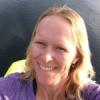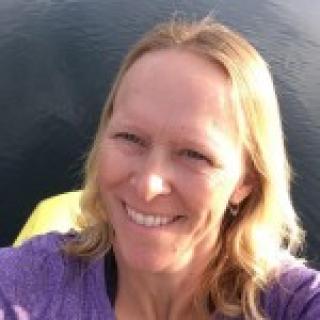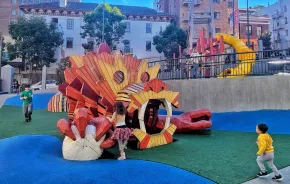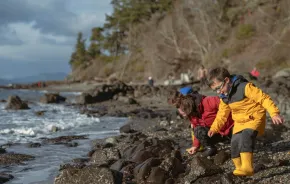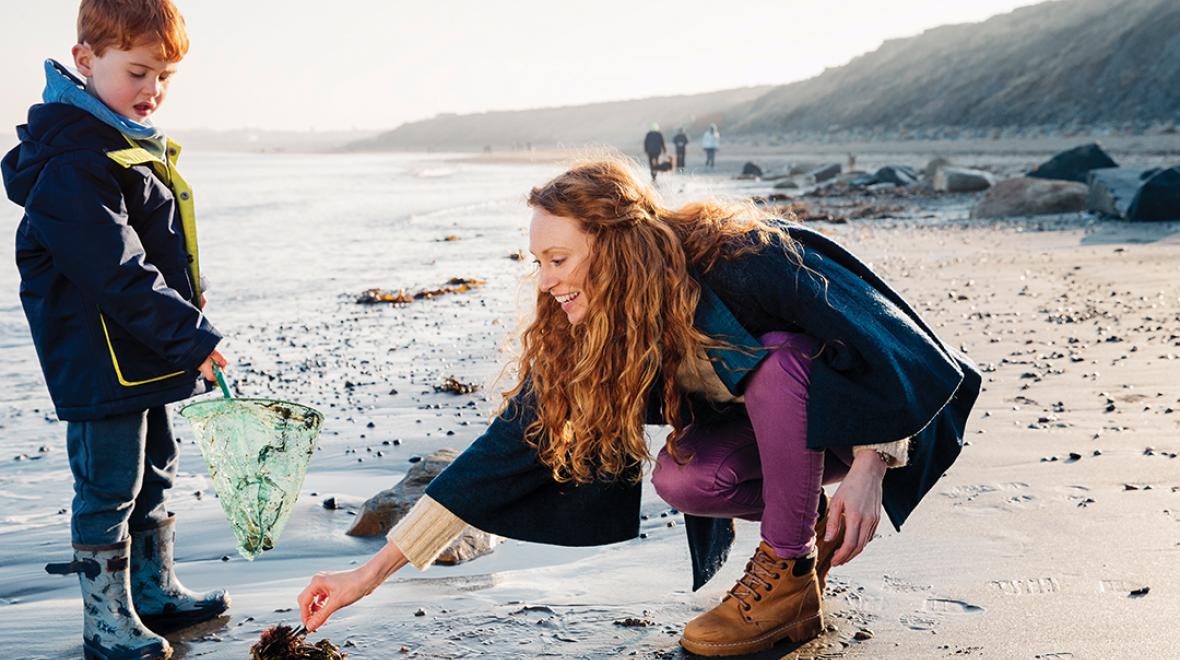
From exercise and relaxation to counting birds and butterflies for the sake of science, people hike trails for many reasons. Some community scientists, people who volunteer their time to collect data in collaboration with professional scientists, are using their time outdoors to make a big difference in our trail community. They use trails that the Washington Trails Association (WTA) helps maintain, they contribute to land conservation that allows for the creation of new trails and they track the health of the ecosystems surrounding those trails. But what exactly does a community scientist do? And what makes them different from an outdoor enthusiast?
Monitoring meadows
Janneke Hille Ris Lambers is a biology professor at the University of Washington whose research focuses on understanding the biological impacts of climate change on plants. Many scientists, particularly those studying climate change, need to collect a wide variety of data over a long period of time to truly see climate change in action. Lambers is the creator of MeadoWatch, a community science program that collects data on plant communities in Mount Rainier National Park.
“I consider MeadoWatch part of my research,” says Lambers. “It’s been great as a way to communicate science to nonscientists, but also as a way to generate a lot of high-quality data about wildflower phenology [the timing of flowering, fruiting and seed production], something many in my lab are interested in.”
‘I would define a citizen scientist as someone who is not necessarily trained as a scientist, but is helping collect and/or process data relevant to a scientific question.’ — Janneke Hille Ris Lambers
Lambers started MeadoWatch after receiving an award from the National Science Foundation. Launched in 2013 with roughly 40 volunteers, the program now has more than 150 people who commit to hiking trails and gathering data during the summer months on two trails in Mount Rainier National Park.
“I would define a citizen scientist as someone who is not necessarily trained as a scientist, but is helping collect and/or process data relevant to a scientific question; [someone] not just interested in science, but actually participating,” she says.
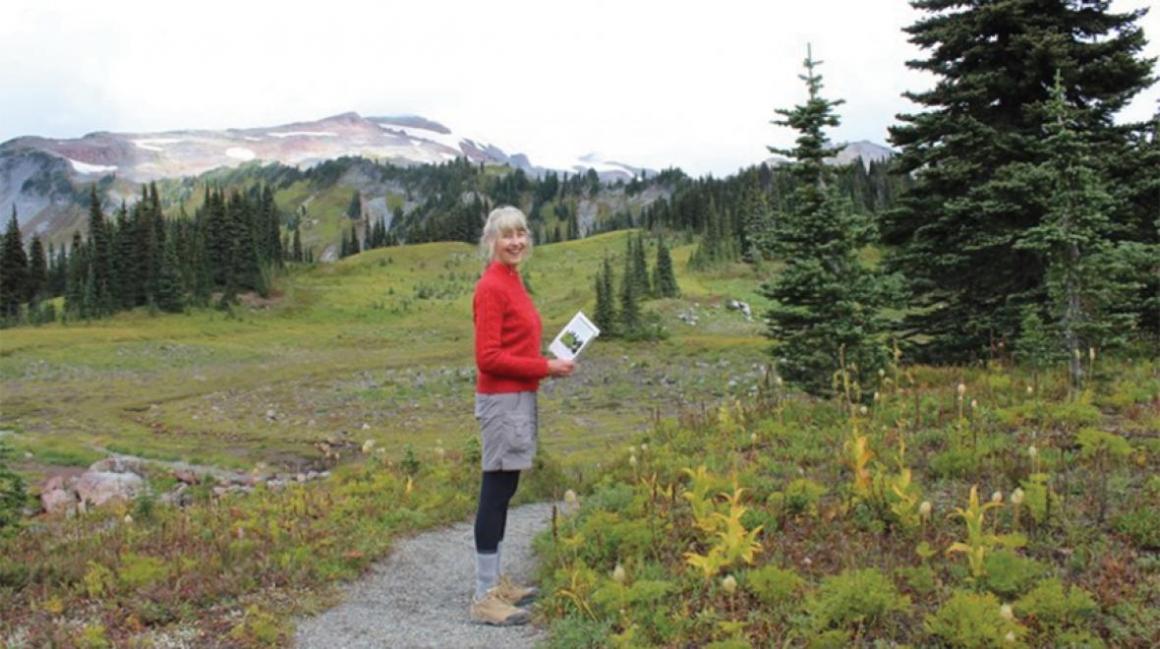
Volunteers must attend a three-hour orientation that gives them some scientific background, teaches them about the data they are going to collect and goes over species identification. They then pick one of two trails and sign up for specific days. As they hike, volunteers stop at between 11 and 17 marked locations along the trail. At each location they outline a plot and look for between four and six species listed on a data sheet. They mark which stages of reproduction, or phenophases, they see in those species.
Lambers says she and her lab are sold on community science because it provides quality data and increases awareness of trails and the ecosystems surrounding them. It also allows regular hikers a chance to learn more about what they see and the changes they observe firsthand. The analyses done by Lambers and her lab directly impact trails and the vistas we admire as we hike them. Issues such as species decline and plant adaptation as a result of longer or shorter growing seasons would be difficult to study without the input of a large body of people on the trail making regular observations.
120 years of bird counts
Birders are a large part of the trail community, often using urban and backcountry trails. Started in 1900, the Audubon Society’s Christmas Bird Count is one of the longest-running community science efforts in the country. Each year, people all over North America participate in this survey of bird species (free for participants), collecting data that allow for the study of long-term trends in bird populations.
In 2019, volunteers counted 60 million birds comprising over 2,000 different species. The data, gathered from North America and across the globe, has been used by scientists to evaluate bird populations, migratory routes, species decimation and habitats — and all of this is thanks to the efforts of volunteers who are community scientists.
In Washington, Audubon has also collaborated with the Washington Department of Fish and Wildlife (WDFW) to monitor three birds that depend entirely on sagebrush ecosystems: Brewer’s sparrow, sage thrasher and sagebrush sparrow.
The Sagebrush Songbird Survey began in 2014 and concluded in the summer of 2019. In that time, almost 300 community scientists visited one or more sites on a monthly basis to document species’ presence during the spring breeding season. The results were entered into eBird, the world’s largest biodiversity-related community science database. Gathered data will affect conservation and land-use planning, and potential scientific studies for these areas.
“I find watching birds much more interesting if I can contribute information and feel that it’s helping us gather a better understanding of habitat and populations,” says Lindell Haggin, president of the Spokane Audubon Society.
‘One of the most exciting things about citizen science is that everyone can participate. Whether it’s a family with small children, working professional or retired persons ... ’ — Stephanie Kuhns
Stephanie Kuhns, citizen science coordinator for WDFW, feels strongly that projects like these help people experience trails and habitats more deeply. “People who participate in citizen science projects gain an increased appreciation for the natural world. This can result in better stewardship practices and participation in projects such as trail work, habitat restoration or other citizen science projects.”
WDFW has four additional active community science projects across the state, all of which involve species that are uncommon, rare or represented by small populations. These projects include a collaboration with the Washington Butterfly Association to survey butterflies in eastern Washington and projects that conduct surveys of bumblebees, freshwater mussels and short-eared owls.
Another Audubon member from Spokane, Kim Thorburn, began monitoring the greater sage grouse with the WDFW in 2009, when the department was translocating birds to boost the dwindling population in central Washington. Thorburn’s reports to wildlife biologists were thorough and invaluable, according to the district’s wildlife biologist.
Eventually Thorburn became interested in doing more, and consequently pursued a spot on the state Fish and Wildlife Commission. She was appointed as a commissioner in 2015. She now uses her expertise to provide direction for the harvesting of fish and wildlife and the protection of habitat in Washington.
Coastal seabirds
Beach and coastal trails are one of the best parts of living in western Washington. Our species’ natural affinity for the ocean often results in disturbance to coastal habitat, but it also means that people are very invested in the well-being of those places.
The Coastal Observation and Seabird Survey Team (COASST) is a community science program run through the University of Washington that uses beached birds as a standard monitoring unit. Measuring dead birds may be off-putting for some, but the stories the birds’ bodies tell are useful and they can be identified by anyone.
Coastal seabird biologist Julia Parrish began the program to establish baseline data that would document marine changes. COASST’s effect over the past 19 years, since its beginnings in 2000, has been significant. The data collected by volunteers has been used by a broad array of domestic and international agencies and scientists to document the consequences of events such as oil spills, harmful algal blooms and fishery bycatch.
‘A lot of cool discoveries can come from making repeated observations. You get to know a place and what you expect to see there, and so you notice when something unexpected shows up.’ — Hillary Burgess
From a starting size of 12 volunteers collecting data on five beaches, COASST has steadily grown to more than 1,000 volunteers covering nearly 450 beaches from Alaska to Northern California. The breadth of the data has also expanded from beached birds. COASST now also tracks marine debris and human beach usage, and it serves as a sister program to similar groups collecting beached-bird data in Russia and Argentina.
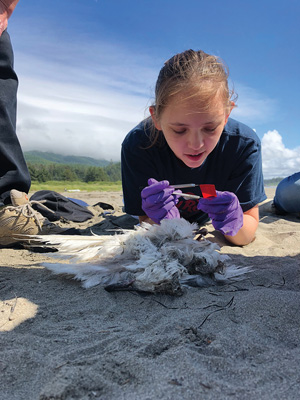
After six hours of training, volunteers commit to survey a specific beach once a month. This regular collection allows COASST to provide high-quality data that can stand up to repeated scientific scrutiny. When volunteers encounter a beached bird, they take photographs and measurements, record characteristics about the condition of the bird and determine what species it is using a specialized guide.
Science coordinator Hillary Burgess says, “The COASST standard is that all data can be verified independently — by experts — so we know exactly how accurate our participants are. A stunning 85 percent of birds are identified correctly to species — and that’s over 100 species and counting.”
Burgess adds that “a lot of cool discoveries can come from making repeated observations. You get to know a place and what you expect to see there, and so you notice when something unexpected shows up.”
WDFW’s Stephanie Kuhns agrees. “One of the most exciting things about citizen science is that everyone can participate. Whether it’s a family with small children, working professionals or retired persons, there are projects all over the world that can benefit from however much time people can contribute.”
Many see community science as a way of deepening our appreciation of the natural world and learning more about the science that goes into enhancing our understanding of what happens on and near the trail. Check out opportunities to stretch your science muscles on a trail near you!
How to get kids involved in climate action |
Editor's note: This article originally appeared in Washington Trails Magazine.



